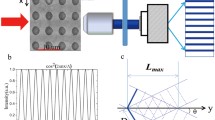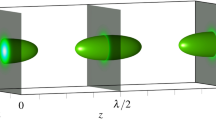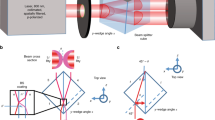Abstract
For the purpose of characterization and improvement of the HHG (High-order Harmonics Generation) eXtreme Ultra-Violet (XUV) coherent beam at the wavelength 30 nm, we developed a unique wavefront sensor based on PDI (Point Diffraction Interferometer) technique. A simple self-referencing monolithic device produces interferometric pattern with encoded information about the wavefront profile of the measured beam. We describe the development, fabrication, and alignment of the sensor, as well as the obtained results and their interpretation.
Access provided by CONRICYT-eBooks. Download conference paper PDF
Similar content being viewed by others
1 Introduction
We designed and fabricated an XUV PDI sensor for HHG beam wavefront measurements. The main motivation was obtaining a device able to analyze the OPD (Optical Path Difference) phase map of the HHG beam which has been used in various experiments at the PALS (Prague Asterix Laser System) laboratory [1]. This information indicates aberrations in the beam wavefront and also provides valuable data about the generating source. With implementation of a suitable phase corrector (a deformable mirror) such setup will bring new features to the investigated HHG beam (e.g., smaller focal spot size, better properties for interferometric experiments, etc.) and will make it possible many new applications.
2 Measured HHG Beam Specifications
The High-order Harmonics (HHG ) are generated by the Titan:sapphire ultrashort laser pulses (central wavelength 810 nm, energy 1.2 mJ, duration 35 fs, repetition 1 kHz) focused into a gas cell filled with Argon. Nonlinear effects involved in HHG generation produce a narrowly collimated XUV beam, which is in the given experimental conditions the 27th harmonics of the Titan:sapphire laser [2], with wavelength of 30 nm, pulse energy 1–10 nJ and with duration 35 fs. The beam with divergence <1 mrad is generated at frequency 1 kHz.
3 PDI : XUV Wavefront Sensing Technique
At present there exist many wavefront profile sensing techniques available in visible and IR domain of the spectrum. However, these techniques are not easily applicable for the XUV region, with calibration being one of the most difficult issues. With currently available XUV optics, calibration is not a straightforward task due to their parameters such as unavailability of efficient and high-quality beam splitters. On these grounds, we decided to design a PDI (Point Diffraction Interferometer) wavefront sensor as this constitutes a self-referencing device that does not require calibration.
The sensor itself consists of a miniature pinhole and a thin foil (as presented in Fig. 14.1). The pinhole is positioned in the axis of the XUV focal spot and it works as a diffraction aperture that generates a reference spherical wave from the part of the XUV beam. The rest of the beam is transmitted through the foil (semitransparent for the selected XUV radiation) that acts as a “density filter”. The essential condition for obtaining well-contrasted interferometric fringes is that the signal level generated by the pinhole must be equal to the signal contained in the transmitted beam. This condition is ensured by selection of an appropriate thickness of the foil, which determines the transmitted signal level. An XUV detector located behind the PDI sensor captures the interferogram, which arises as an interference between the reference spherical wave and the original (measured) wave. By using a deconvolution software it is possible to reconstruct the incident beam wavefront profile from the information encoded in the interferometric pattern.
The theoretical design and calculation of the PDI sensor parameters has been thoroughly described in the [3]. The resulting parameters are following: (1) Filter material Al, (2) Filter thickness 1.5 µm, (3) Pinhole diameter 3.5 µm, (4) Maximum allowed energy in incident beam to avoid foil ionization 0.11 µJ, (5) Phase difference between reference and signal due to phase shift in the material of the foil 2.5 lambda.
4 Fabrication of PDI Sensor
The fabrication process involved production of the ultra-thin aluminum foil and the micro pinhole. The high-quality homogeneous foil was commercially obtained in a plastic frame (∅ 28.4 mm). In this foil, we produced a set of twelve circular pinholes with various diameters ranging from 1 to 10 µm (distance between holes 0.5 mm) which provide a device for testing different configurations of the pinhole and/or the focus. The pinholes were made by a custom micropattering procedure utilizing the focused ion beam, resulting in highly precise pinholes with high circularity and with high-quality edges. Additionally, for alignment of the sensor to the optical axis a rectangular aperture (30 × 10 µm), serving to navigation and alignment, was produced along with the array of the individual pinholes.
5 Measurement
The experimental setup of the HHG wavefront profile measurement is represented in Fig. 14.2. It contains an XUV detector (X-ray camera Andor DX-440), the PDI sensor and an XUV off-axis parabolic mirror (f = 254 mm, angle between the incident and reflected beam 14°). During the experiment, we temporarily replaced the parabolic mirror with a spherical mirror (f = 250 mm), in order to deform deliberately the measured wavefront with astigmatism aberration and thereby to demonstrate the PDI sensor detection ability.
The alignment procedure of the PDI sensor is illustrated in Fig. 14.3. For rough adjustment to the beam focus, an optical telemicroscope (with 8 × magnification) has been used. By acquiring the IR Titan:sapphire laser focal point (the IR and HHG beams propagate coaxially) on the sensor foil by the telemicroscope we were able bringing the navigation rectangular aperture to this focal point. The fine alignment has been done using a spherical mirror (f = 125 mm) and another XUV detector (PI Roper Pixis), forming an optical imaging system with the magnification factor ten times. The object plane was the back surface of the PDI foil, therefore, we were able observing simultaneously the selected pinhole (backlight illuminated by a LED diode) and the HHG focus spot. This enabled us bringing the hole to the HHG focus, utilizing a precise motorized stage (adjustable in x, y, z directions) under vacuum. Afterward, the imaging mirror and the LED illuminator were remotely removed out of the beam trajectory and the PDI sensor became ready for the XUV wavefront measurement as shown in the scheme in Fig. 14.2.
6 Simulations and Acquired Experimental Data
The acquired data are presented in Figs. 14.4, 14.5 and 14.6, along with the corresponding computer simulations created in the Matlab software. In the experiment, the distance between the focusing parabolic mirror and the PDI sensor was 254 mm, and the distance between the PDI sensor and the detector was 295 mm. When the off-axis parabola was replaced by the spherical mirror (in order to deliberately introduce astigmatism), the distance between the focusing spherical mirror and the detector was decreased to 250 mm.
The simulations have been calculated concerning the Gaussian beam propagation and they take into the account only aberrations introduced by the focusing optics (astigmatism in Figs. 14.5a, b and 14.6a, b) and does not include other aberrations in the real measured beam. A decent correlation between the simulated and measured results indicates high-HHG beam wavefront quality. The measured data confirm the operation ability of the sensor.
7 Wavefront Data Analysis
Using the measured data accurate wavefront analysis was carried out by using a commercially available software. The results indicate presence of higher orders (equal to or higher than 3) of optical aberrations in the measured XUV beam, as illustrated in Fig. 14.7. The analyzed interferograms suggest wavefront distortions with rms of typically 0.8 (varying between 0.4 and 0.9 on day-to-day basis).
Typical example of 3D wavefront profile of the incident XUV beam, corresponding to the interferogram shown in Fig. 14.4a
8 Conclusion
The obtained data represent, to our best knowledge, the first authentic interferometric wavefront sensing in the XUV region. The developed sensor demonstrated capability of PDI technique to provide data exploitable by accurate characterization of the XUV beam wavefront up to 5th order of aberrations. The sensor with the used wavefront analysis technique can be employed to provide data for phase correction in a closed loop, using a deformable mirror with appropriate XUV coating.
References
Rus, B., et al.: Development and applications of multimillijoule soft X-ray lasers. J. Mod. Opt. 54, 2571–2583 (2007)
Jakubczak, K., et al.: Beam properties of fully optimized, table-top, coherent source at 30 nm. Opto-Electron. Rev. 19(2), 169–175 (2011)
Homer, P., et al.: Measurements of X-ray laser wavefront profile using PDI technique. Proc. SPIE 6702, 670211 (2007)
Acknowledgements
Authors acknowledge the support from grants “CZ.1.05/1.1.00/02.006”, “CZ.1.07/2.3.00/20.0091”. We thank Dr. Ales Jäger from the Institute of Physics ASCR, v.v.i., for pinhole micropatterning and acknowledge support of MEYS LM2015087.
Author information
Authors and Affiliations
Corresponding author
Editor information
Editors and Affiliations
Rights and permissions
Copyright information
© 2018 Springer International Publishing AG
About this paper
Cite this paper
Homer, P., Rus, B., Hrebicek, J., Nejdl, J. (2018). HHG Beam Wavefront Characterization at 30 nm. In: Kawachi, T., Bulanov, S., Daido, H., Kato, Y. (eds) X-Ray Lasers 2016. ICXRL 2016. Springer Proceedings in Physics, vol 202. Springer, Cham. https://doi.org/10.1007/978-3-319-73025-7_14
Download citation
DOI: https://doi.org/10.1007/978-3-319-73025-7_14
Published:
Publisher Name: Springer, Cham
Print ISBN: 978-3-319-73024-0
Online ISBN: 978-3-319-73025-7
eBook Packages: Physics and AstronomyPhysics and Astronomy (R0)











